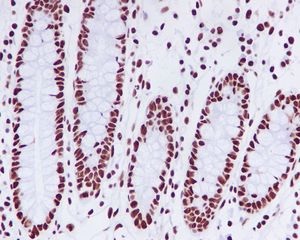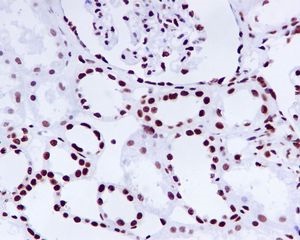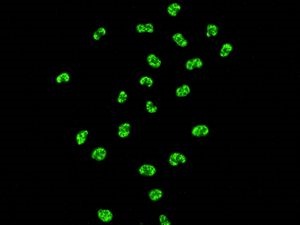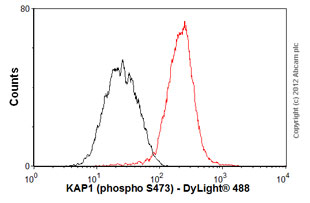![All lanes : Anti-KAP1 antibody [EPR5249] (ab109545) at 1/50000 dilutionLane 1 : A431 cell lysateLane 2 : A431 cell lysate treated with Lambda PhosphataseLane 3 : MCF7 cell lysateLane 4 : MCF7 cell lysate treated with Lambda PhosphataseLysates/proteins at 10 µg per lane.](http://www.bioprodhub.com/system/product_images/ab_products/2/sub_3/11352_KAP1-Primary-antibodies-ab109545-1.jpg)
All lanes : Anti-KAP1 antibody [EPR5249] (ab109545) at 1/50000 dilutionLane 1 : A431 cell lysateLane 2 : A431 cell lysate treated with Lambda PhosphataseLane 3 : MCF7 cell lysateLane 4 : MCF7 cell lysate treated with Lambda PhosphataseLysates/proteins at 10 µg per lane.

ab109545, at a 1/100 dilution, staining KAP1 in formalin-fixed, paraffin-embedded Human colon tissue.

ab109545, at a 1/100 dilution, staining KAP1 in formalin-fixed, paraffin-embedded Human kidney tissue.

ab109545, at a 1/100 dilution, staining KAP1 in HeLa cells

Overlay histogram showing HeLa cells stained with ab109545 (red line). The cells were fixed with 80% methanol (5 min) and then permeabilized with 0.1% PBS-Tween for 20 min. The cells were then incubated in 1x PBS / 10% normal goat serum / 0.3M glycine to block non-specific protein-protein interactions followed by the antibody (ab190545, 1/100 dilution) for 30 min at 22ºC. The secondary antibody used was DyLight® 488 goat anti-rabbit IgG (H+L) (ab96899) at 1/500 dilution for 30 min at 22ºC. Isotype control antibody (black line) was rabbit IgG (monoclonal) (1µg/1x106 cells) used under the same conditions. Acquisition of >5,000 events was performed.
![All lanes : Anti-KAP1 antibody [EPR5249] (ab109545) at 1/50000 dilutionLane 1 : A431 cell lysateLane 2 : A431 cell lysate treated with Lambda PhosphataseLane 3 : MCF7 cell lysateLane 4 : MCF7 cell lysate treated with Lambda PhosphataseLysates/proteins at 10 µg per lane.](http://www.bioprodhub.com/system/product_images/ab_products/2/sub_3/11352_KAP1-Primary-antibodies-ab109545-1.jpg)



